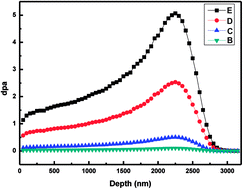Direct characterization of ion implanted nanopore pyrolytic graphite coatings for molten salt nuclear reactors
Abstract
Nanopore pyrolytic graphite coatings (PyC, average pore size ∼64 nm) were prepared on graphite to inhibit liquid fluoride salt and Xe135 penetration. The samples were irradiated with 7 MeV Xe26+ to a total peak dose of 0.1, 0.5, 2.5 and 5.0 displacements per atom at room temperature to study the irradiation resistance of the PyC. The effect of irradiation on the properties of the graphite was evaluated. With the increase of irradiation dose, the surface morphology of the coatings tends to be smoother. At the total peak dose of 2.5 dpa, peeling and spalling on the surface of the samples have been identified, indicating the surface microstructure of the graphite has been damaged by Xe26+ bombardment. Raman results indicated the increase in the degree of disorder and decrease of in-plane crystallite size with the irradiation dose, and the new PyC was more sensitive to irradiation than IG-110 graphite. The nanohardness at peak dose increased with the irradiation dose, but decreased at 2.5 dpa. The results of a hardness test also show PyC has a higher irradiation sensitivity.



 Please wait while we load your content...
Please wait while we load your content...